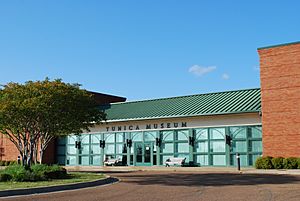Tunica Museum facts for kids
 |
|
| Established | 1997 |
|---|---|
| Location | 1 Museum Blvd Tunica, Mississippi |
| Type | History museum |
The Tunica Museum is a cool place in Tunica, Mississippi. It teaches all about the history of Tunica County. The museum opened in 1997. It was built with money from local casinos.
The museum has a large area for its main exhibits. It also has space for special, changing displays. You can take a tour by yourself, and it's free to enter!
Contents
Discovering Tunica's Past
The idea for the Tunica Museum came from a group of local people in 1997. They wanted a place to share the county's story. Their goal was to show the history of Tunica County. This includes its natural setting and early people. It also covers how people lived in the 1800s and 1900s. The museum aims to show the many different cultures in the county. Money from casino gambling in Tunica County helped make the museum possible.
Main Exhibits: A Journey Through Time
The museum's main exhibits take you on a journey. They start with the very beginning of Tunica County.
Nature and Early People
The first room looks like a forest. It shows animals that live in the area. You can see birds, bobcats, and even a life-size black bear. Next, you learn about the ancient mound-building people. This includes the Tunica people. Panels explain how these Native Americans lived. There is also a video that tells their story. One special dig site, called the Hollywood site, is highlighted. It shows the work done by archaeologists from the University of Mississippi.
European Explorers Arrive
The museum also shows how Tunica changed when Europeans came. It talks about early Spanish explorers. The exhibits suggest that Hernando de Soto might have first seen the Mississippi River in Tunica County. This idea comes from old descriptions by de Soto's group. This topic has been discussed by historians for many years. You can see a life-size conquistador. This shows what early Spanish explorers looked like.
Life on Plantations
For many years, northern Mississippi, including Tunica County, was home to the Chickasaw tribe. The museum explains how the Chickasaw tribe gave up their land. This happened through agreements like the Treaty of 1818. After this, people started to settle the area. Exhibits show how the land was cleared for farms. Many large plantations were built. The land was great for farming. The Mississippi River's floods made the soil very rich. This part of the museum has a full-size mule and wagon. It also has a real plantation bell. You can also see a recreated plantation store. There are displays about the widespread use of slavery in Tunica during this time.
Changes After the Civil War
After the Civil War, new laws called Jim Crow laws were put in place. The museum tells stories about this time. It talks about groups like the Red Shirts (Southern United States). These groups caused problems for African Americans. The exhibits also cover farming challenges. These include fighting the boll weevil insect. They also show the impact of the Great Mississippi Flood of 1927. Another big change was the Great Migration. Many farm workers moved away from the area.
Daily Life and Modern Times
Displays show what daily life was like in Tunica. You can see parts of an old barbershop and a movie theater. Tunica County has faced challenges with poverty. One display talks about a neighborhood called Sugar Ditch. This area received national attention because of its living conditions. The Reverend Jesse Jackson's work related to Sugar Ditch is also part of the display.
In 1992, casino gambling came to Tunica County. The Splash Casino was the first to open. The museum has a display about how casinos changed Tunica County. It includes a slot machine and a casino card table. There is also a video about casinos.
Beyond History: Local Treasures
After the history exhibits, there are other displays. You can see a cotton bale. There are also samples of rice, soybeans, and corn from local farms. One board shows important people from Tunica County. It tells you what they did. The last part of the museum has many stuffed animals found in Tunica. This includes many large birds.
Key Ideas at the Museum
The Tunica Museum focuses on a few main ideas:
- Race and Community: The museum explores how different races have lived together in Tunica. It covers slavery, segregation, and current issues.
- Land and Farming: Tunica's economy has always been linked to farming. The museum shows how important the land and climate are.
- Everyday Life: You can learn about the daily lives of people who have lived in Tunica County.
Other Things to See and Do
The museum also manages the Tate Log House. This is the oldest building in the county. You can visit it in downtown Tunica. It shows how people lived long ago.
Behind the museum, there is a nature walking trail. All visitors can enjoy it.
The museum also hosts special events and exhibits. For example, in 2013, they had displays about blues musicians and about Abraham Lincoln, the Constitution, and the Civil War.
The Tunica Museum is part of the Mississippi Museums Association. This group helps museums across the state.
Images for kids


